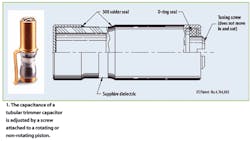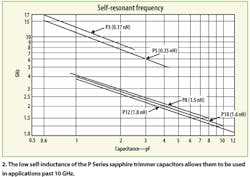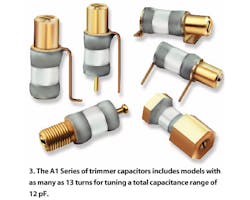This file type includes high resolution graphics and schematics when applicable.
Capacitors are essential circuit elements that store and supply charge on demand. With inductors and resistors, they are the building blocks of passive circuits and the supporting components for active circuits While fixed-value capacitors over a wide range of values are used in the majority of electrical circuits, it is sometimes preferable to use a component with a variable capacitance range, for example, for the purpose of experimentation or for adjusting the center frequency of a bandpass filter. Such capacitors are known as trimmer capacitors for their capability of trimming the performance of both active and passive circuits.
Design engineers are often faced with trade-offs, and the choice of fixed versus trimmer capacitor is one of those trade-offs. A trimmer capacitor may cost more than a fixed-value capacitor, but also provides more flexibility. At one time, fixed-value capacitors were clearly smaller than trimmer capacitors, but recent developments in chip-style trimmer capacitors have closed the gap in physical dimensions between the two capacitor types. When capacitance tolerance is an issue, the use of fixed-value capacitors with tight tolerances usually commands a premium price. It can often be more practical to substitute a trimmer capacitor for a high-tolerance fixed capacitor and tune to the required tolerance.
Even in high-volume production, where it is generally assumed that fixed-value capacitors will be used, this is a choice that depends on the amount of tuning required. For example, circuits with frequencies that may need adjustment, such as filters and crystal oscillators, can benefit from the tuning flexibility of a trimmer capacitor. And in post-production, having to change a printed-circuit board (PCB) with a fixed capacitor due to aging effects, frequency drift, or manufacturing variability can mean a complete reworking of a PCB and the associated time and expense. Such rework can be avoided by strategic placement of trimmer capacitors.
Trimmer capacitors typically cover a capacitance range between 1 or 2 pF and to as much as 200 pF or more. A fixed capacitor is essentially two metal plates that hold charge. In a trimmer capacitor, these plates, the stator and rotator plates, are either adjusted in distance from each other or shifted in amount of exposed area to each other to change the amount of capacitance. Some form of dielectric, such as air, ceramic, glass, polytetrafluroethylene (PTFE), and sapphire, is used as electrical insulation between the plates or other metalized surfaces. The precision and repeatability of the tuning element contributes mightily to the accuracy and stability of a trimmer capacitor's capacitance value.
Trimmer capacitors can be designed with a variety of structures, including tubular and plate designs. The capacitance changes by moving a piston inside of a dielectric tube which has been metalized on the outside. As the piston overlaps with more of the stator plates, the capacitance increases. Variations include using a piston with a movable set of concentric metal rings fitted into a fixed set of parallel rings. As the rings mesh, the capacitance increases.
In a tubular trimmer capacitor, the capacitance can be adjusted by means of a rotating or non-rotating piston that is permanently attached to an adjusting screw (Fig. 1).
In a rotating tubular design, the piston-screw assembly turns within a threaded bushing in a partially metalized dielectric tube. As the piston engages a greater portion of the metalized part of the dielectric tube, the capacitance increases. The design is relative easy to assemble and low in cost, although variations in the mating parts can result in tuning irregularities as extreme as ±10%.
In a non-rotating design, the piston is placed on bushing rails and is driven by a screw that's captured in the bushing and does not move axially. As the screw is turned, the piston slides along the rails and moves into the metalized area of the dielectric tube. Because the piston does not rotate, the air gap stays constant and tuning is linear within ±1% versus ±10% on the rotating version. In contrast to the rotating design, this approach offers better stability with shock and vibration. Since current runs along the bushing rails and not along the screw, the inductance is lower and higher self-resonant frequencies (SRFs) can be achieved. By using a screw with fine threads, multiple turns of capacitance adjustment can be provided with extremely high adjustment resolution.
The space between metalized surfaces in a trimmer capacitor can be filled with a variety of dielectrics, including air, ceramic, glass, PTFE, and sapphire materials. Air-dielectric trimmer capacitors offer the least insulation between charged surfaces and tend to be limited in voltage handling capabilities and capacitance value, while trimmer capacitors using glass, quartz, and PTFE dielectric materials provide sufficient insulation for higher voltage ratings and can achieve higher values of capacitance.
For higher-frequency applications in which high quality factors (Qs) and high SRFs are essential, multi-turn trimmer capacitors based on air, sapphire, or PTFE dielectric materials provide the lowest loss and best overall performance. The amount of insulation provided by the dielectric material contributes to the voltage rating of a trimmer capacitor, usually given as its DC withstanding voltage. For example, PTFE exhibits a higher dielectric constant that air (which is equal to unity) and can support trimmer capacitors with a much-higher DC withstanding voltage rating (on the order of 15,000 V or more).
Trimmer capacitors based on ceramic dielectric material are small and inexpensive, and readily available on tape and reel for use with automated manufacturing machines. They can be specified with capacitance ranges to about 40 pF and are well suited for applications requiring small size and low cost. But ceramic trimmer capacitors tend to suffer from only average temperature stability, which degrades with increasing capacitance. These components are available with Q of about 1500 at 1 MHz, with nominal temperature coefficient of 0 to –750 ppm/°C. Capacitance drift tends to be about ±1 to ±5 percent while the maximum withstanding voltage is 220 VDC or less.
Sapphire is a chemically insert material; the value of its dielectric constant does not change with frequency and it features loss characteristics that are consistently low even above 10 GHz. For example, in the P series of sapphire trimmer capacitors from Voltronics Corp. (www.voltronicscorp.com), the low self-inductance of these trimmer capacitors allows them to be used in applications past 10 GHz (Fig. 2, plot of self-resonant frequency versus capacitance). The P Series components employ an O-ring seal to prevent contamination from flux and cleaning fluids.
Once an engineer has decided on the benefits of trimmer capacitors for a particular design, the choices are many and should be carefully considered when matching a trimmer capacitor to an application. In addition to the many different dielectric types, trimmer capacitors are also available in numerous package styles, including those designed for printed-circuit-board (PCB) mounting panel mounting, and surface-mount applications. Trimmer capacitors are even available for low-temperature applications in cryogenic systems and manufactured without magnetic materials for use in critical industrial and medical applications, such as magnetic-resonance-imaging (MRI) systems.
Page Title
A number of general specifications can be used when comparing the performance of trimmer capacitors, including the capacitance range, the number of turns required to cover the capacitance range, the SRF, the minimum Q, temperature coefficient, tuning torque, DC working voltage, and DC withstanding voltage. In comparing components from different manufacturers, it is important to normalize values as much as possible, since manufacturers may use different reference points for their measurements. For example, when the Q is listed, note also the frequency at which it is measured (which can range from 1 to 250 MHz) as well as the capacitance at which it is specified (which can be anywhere in the capacitance tuning range). The higher the value of Q, the higher in frequency a trimmer will operate. Since Q is a function of frequency (decreasing with increasing frequency), any comparison between trimmer capacitors from different suppliers should be referenced to a common frequency, such as 1 MHz or 100 MHz. In addition, note the capacitance value for the SRF, which may also be measured at any capacitance value within the tuning range. In considering components from different manufacturers, use the same capacitance value to compare the SRFs of two different models.
The capacitance range and the number of turns to adjust that range determine the amount of control over a capacitance setting. Trimmer capacitors are available in low-cost models with 1 to 2 pF of capacitance and one-half turn to units with tuning ranges to 250 pF and more and multiple turns of adjustment. Put simply, for more control, specify a trimmer capacitor with a greater number of turns for a given capacitance range. For example, the low-cost A1 Series of trimmer capacitors (Fig. 3) from Voltronics includes models with maximum capacitance values of 4, 8, and 12 pF and seven turns for adjusting the two lower-valued models and 13 turns for adjusting the 12-pF model.
Tuning torque is simply a measure of the force needed to turn a trimmer capacitor's adjustment screw. While this seems obvious, the value should be in a range that provides enough torque to ensure that an adjustment will remain in place once set, and not too much torque to require excessive force in tuning. Generally, a range of about 0.3 to 3.0 inch-ounces is easy enough to turn while also providing a positive feel when setting a capacitance value.
A trimmer capacitor's maximum DC working voltage rating is the typical maximum value of continuous voltage for which that component is designed and tested. The DC withstanding voltage is typically twice the value of the maximum working voltage rating and is a short-term value above which damage will usually occur. The voltage rating generally depends on the size of the capacitor and the type of dielectric material used in the trimmer capacitor, with high-isolation materials such as PTFE capable of handling fairly high voltage levels. For example, the NT series of PTFEdielectric trimmer capacitors from Voltronics feature DC working voltage ratings as high as 7500 V and DC withstanding voltages as high as 15,000 V. They provide capacitance tuning ranges as wide as 2 to 100 pF, although the high-voltage rating comes in a relatively large component measuring about 5 in. in length (Fig. 4).
The choice of dielectric material is often dictated by the requirements of an application. As previously mentioned, sapphire dielectric materials offer a low loss tangent and good high-frequency performance with high voltage capacity. Sapphire is mechanically strong and moisture resistance, and does not exhibit changes in dielectric constant with frequency, making it an ideal dielectric material for applications requiring high stability. Higher-voltage ratings are possible with PTFE-based trimmer capacitors, and are not subject to the ionization problems suffered by low-loss air-dielectric trimmers in space applications. For military applications, trimmer capacitors should be specified according to the required temperature range (–65 to +125°C) as well as to MIL-PRF-14409 specifications which call out screening of parts according to specific levels of mechanical shock and vibration.
In addition to specifying the required operating temperature range, an engineer should also understand the effects of temperature on a trimmer capacitor's set value, as represented by the component's temperature coefficient. The temperature coefficient presents a component's amount of capacitance deviation in parts per million (ppm) per degree of temperature change. A smaller value of temperature coefficient represents a more stable capacitor. When comparing models from different manufacturers, it is important to compare the temperature coefficient values for the same capacitance range. For example, the temperature coefficient for a Voltronics A1 series PTFE-dielectric trimmer with tuning range of 0.5 to 8 pF is 0 ± 100 ppm/°C For a trimmer capacitor in the same series but with a narrower tuning range of 0.45 to 4 pF, the temperature coefficient is a more impressive 0 ± 50 ppm/°C, although the number has dropped because of the lower maximum capacitance value.
A recent development in trimmer capacitors is the availability of low-cost, chip-size trimmer capacitors that can take the place of fixed-value chip capacitors with little sacrifice in PCB real estate. For example, the J Series ceramic chip capacitors from Voltronics are only slightly larger than fixed-value chip capacitors, but with adjustable tuning ranges.
The firm's JN Series trimmers (Fig. 5) measure only 0.067 X 0.059X 0.035 in. (1.7 X 1.5 X 0.9 mm) but provide adjustable capacitance from 1.5 to 4.0 pF. The model JN010 tunes from 0.55 to 1.0 pF with SRF of 6 GHz and Q of 500 at 1 MHz. The temperature coefficient is 0 ± 50 ppm/°C. As with any engineering choice, there is a trade-off for the small size of the JN010, and it is in voltage capacity: The component has DC working voltage of 25 V and DC withstanding voltage of 55 V.
How much smaller can trimmer capacitors be made? In practical terms, some size must be allowed for physical tuning, although this does not eliminate the possibility of trimmer capacitors adjusted by means of electronic tuning. For example, numerous firms working with microelectromechanical-systems (MEMS) technologies as well as with metamaterials capable of changing dielectric constant with applied voltage have developed embedded variable capacitors in such applications as electronically tunable filters and impedance-matching networks.
For example, tunable filters with MEMS-based variable capacitors developed by Paratek Microwave, Inc. (www.paratek.com) are being employed in the Joint Tactical Radio Service (JTRS) program as part of the RF section of software-defined-radio (SDR) tactical radios. One of the company's electronically tunable filters has been able to replace dozens of fixed, discrete filters. The company's Parascan™ thin-film ceramic materials, which are based on a doped version of barium strontium titanate (BST), feature a dielectric constant that changes with applied DC voltage. Similarly, Agile Materials & Technologies (www.agilematerials.com) has also applied innovative materials and MEMS technology to produce electronically tunable impedance matching networks and filters. A logical extension of the technology is miniature, chip-sized trimmer capacitors with electronically tunable capacitance range.
This file type includes high resolution graphics and schematics when applicable.






